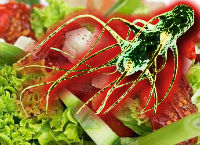Organism Details:
Shape and Size
�0�.�5�-�1� �¼�m�,� �S�p�h�e�r�i�c�a� �s�h�a�p�e�d�.
Genome Information
The genome of Staphylococcus aurenus is a Gram-positive aerobic cocci bacteria. Staphylococcus aurenus strain 502A chromosome ( GI:595636499) has a circular DNA chromosome of 2764699 bp .The genome structure of Staphylococcus aurenus consists of 2,592genes and 2,500 coding proteins, Pseudo Genes: 14, rRNAs: 19 ( 5S, 16S, 23S ),tRNAs: 59 ,Frameshifted Genes: 12. The GC content of Staphylococcus aurenus is about 33% and the percentage coding of the bacteria is about 85%.
Food Source
Vine stalk,Leafy Vegetable,Grain Beans, Pork,Egg,Dairy product,Chicken, Ice cream, cheese),
Salads (egg, tuna, chicken, Potato, macaroni)
Bakery products (cream-filled pastries, cream pies, eclairs)Ham
Pathological Factor
S.aureus has recently been cited as a source of foodborne illness. Toxin can be produced by the microorganism growing in the food. This toxin is called an enterotoxin because it causes gastroenteritis or inflammation of the lining of the intestinal tract. Thorough cooking destroys the Staphylococcus aureus bacteria, but the toxin is very resistant to heat, refrigeration, and freezing.Enterotoxin-producing strains of S aureus cause one of the most common food-borne illnesses: watery diarrhea 2-6 hours after ingestion followed by acute vomiting . Usually show self-limited symptoms.Because of proliferation in toxin-producing organisms in uncooked or partially cooked food that an individual carrying the staphylococci has contaminated but how the exfoliative toxins produce epidermal splitting has not been fully elucidated. The most feared manifestation of S aureus toxin production is toxic shock syndrome (TSS). Although first described in children but most frequently associated with women using tampons during menstruation.
Disease
Staphylococcus aureus is the most common cause of staphylococcus infections and is responsible for various diseases including mild skin infections (impetigo, folliculitis, etc.), invasive diseases (wound infections, osteomyelitis, bacteremia with metastatic complications, etc.), and toxin mediated diseases (food poisoning, toxic shock syndrome or TSS, scaled skin syndrome, etc.).In children, sudden onset of fever and bony tenderness or a limp leads to causes Bone infections (osteomyelitis).While decreased range of motion, tenderness of the joint with constitutional symptoms, erythema ,fever and warmth may lead to causes Septic arthritis;however, these signs may be absent in infants (specially hip joint).
Endocarditis: Initially presents as fever,malaise and peripheral emboli may involve healthy valves.
Toxic shock syndrome affect three or more organ system follwed by fever ,hypotension and diffuse mascular erythema. S.aureus causes pneumonia most commonly in infant ,young children and debiliated patients ,causes fever followed by respiratory distress; prominently show gastrointestinal symptoms.Responsible for thrombophlebitis mainly affecting hospitalized patients. A rare neonates disorder in young children show skin syndrome (Ritter disease).followed by fever, erythema, and blisters, which eventually rupture and leave a red base. Gentle shearing forces on intact skin cause the upper epidermis to slip at a plane of cleavage in the skin, which is known as the Nikolsky sign. How the exfoliative toxins produce epidermal splitting has not been fully elucidated S.aurers infection causes: Pneumonia Infection in Respiratory Tract Cellulitis(skin infections).
Affected Body Organs
pneumonia,respiratory tract
|








